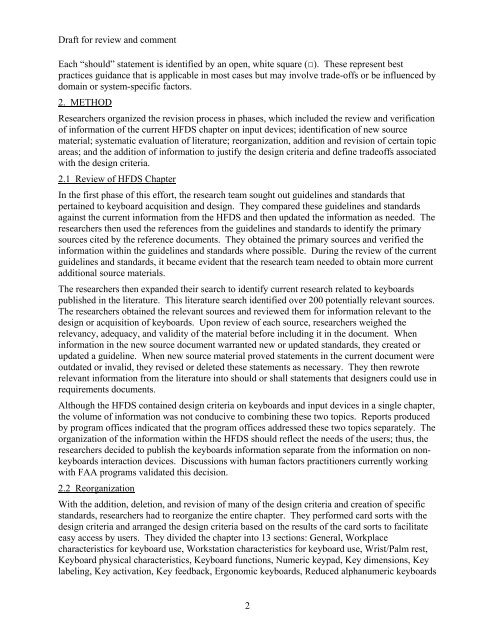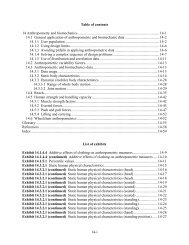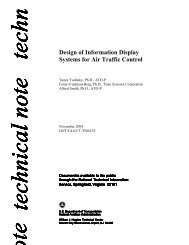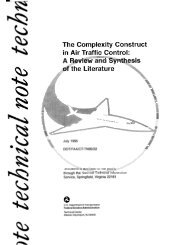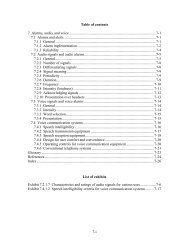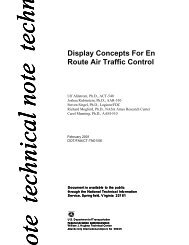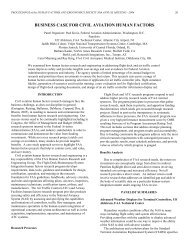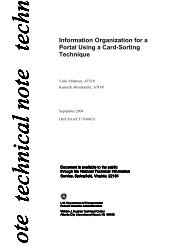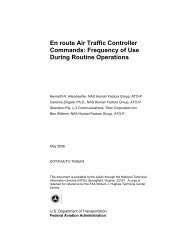Human Factors Criteria for the Design and Acquisition of ... - FAA
Human Factors Criteria for the Design and Acquisition of ... - FAA
Human Factors Criteria for the Design and Acquisition of ... - FAA
Create successful ePaper yourself
Turn your PDF publications into a flip-book with our unique Google optimized e-Paper software.
Draft <strong>for</strong> review <strong>and</strong> commentEach “should” statement is identified by an open, white square (□). These represent bestpractices guidance that is applicable in most cases but may involve trade-<strong>of</strong>fs or be influenced bydomain or system-specific factors.2. METHODResearchers organized <strong>the</strong> revision process in phases, which included <strong>the</strong> review <strong>and</strong> verification<strong>of</strong> in<strong>for</strong>mation <strong>of</strong> <strong>the</strong> current HFDS chapter on input devices; identification <strong>of</strong> new sourcematerial; systematic evaluation <strong>of</strong> literature; reorganization, addition <strong>and</strong> revision <strong>of</strong> certain topicareas; <strong>and</strong> <strong>the</strong> addition <strong>of</strong> in<strong>for</strong>mation to justify <strong>the</strong> design criteria <strong>and</strong> define trade<strong>of</strong>fs associatedwith <strong>the</strong> design criteria.2.1 Review <strong>of</strong> HFDS ChapterIn <strong>the</strong> first phase <strong>of</strong> this ef<strong>for</strong>t, <strong>the</strong> research team sought out guidelines <strong>and</strong> st<strong>and</strong>ards thatpertained to keyboard acquisition <strong>and</strong> design. They compared <strong>the</strong>se guidelines <strong>and</strong> st<strong>and</strong>ardsagainst <strong>the</strong> current in<strong>for</strong>mation from <strong>the</strong> HFDS <strong>and</strong> <strong>the</strong>n updated <strong>the</strong> in<strong>for</strong>mation as needed. Theresearchers <strong>the</strong>n used <strong>the</strong> references from <strong>the</strong> guidelines <strong>and</strong> st<strong>and</strong>ards to identify <strong>the</strong> primarysources cited by <strong>the</strong> reference documents. They obtained <strong>the</strong> primary sources <strong>and</strong> verified <strong>the</strong>in<strong>for</strong>mation within <strong>the</strong> guidelines <strong>and</strong> st<strong>and</strong>ards where possible. During <strong>the</strong> review <strong>of</strong> <strong>the</strong> currentguidelines <strong>and</strong> st<strong>and</strong>ards, it became evident that <strong>the</strong> research team needed to obtain more currentadditional source materials.The researchers <strong>the</strong>n exp<strong>and</strong>ed <strong>the</strong>ir search to identify current research related to keyboardspublished in <strong>the</strong> literature. This literature search identified over 200 potentially relevant sources.The researchers obtained <strong>the</strong> relevant sources <strong>and</strong> reviewed <strong>the</strong>m <strong>for</strong> in<strong>for</strong>mation relevant to <strong>the</strong>design or acquisition <strong>of</strong> keyboards. Upon review <strong>of</strong> each source, researchers weighed <strong>the</strong>relevancy, adequacy, <strong>and</strong> validity <strong>of</strong> <strong>the</strong> material be<strong>for</strong>e including it in <strong>the</strong> document. Whenin<strong>for</strong>mation in <strong>the</strong> new source document warranted new or updated st<strong>and</strong>ards, <strong>the</strong>y created orupdated a guideline. When new source material proved statements in <strong>the</strong> current document wereoutdated or invalid, <strong>the</strong>y revised or deleted <strong>the</strong>se statements as necessary. They <strong>the</strong>n rewroterelevant in<strong>for</strong>mation from <strong>the</strong> literature into should or shall statements that designers could use inrequirements documents.Although <strong>the</strong> HFDS contained design criteria on keyboards <strong>and</strong> input devices in a single chapter,<strong>the</strong> volume <strong>of</strong> in<strong>for</strong>mation was not conducive to combining <strong>the</strong>se two topics. Reports producedby program <strong>of</strong>fices indicated that <strong>the</strong> program <strong>of</strong>fices addressed <strong>the</strong>se two topics separately. Theorganization <strong>of</strong> <strong>the</strong> in<strong>for</strong>mation within <strong>the</strong> HFDS should reflect <strong>the</strong> needs <strong>of</strong> <strong>the</strong> users; thus, <strong>the</strong>researchers decided to publish <strong>the</strong> keyboards in<strong>for</strong>mation separate from <strong>the</strong> in<strong>for</strong>mation on nonkeyboardsinteraction devices. Discussions with human factors practitioners currently workingwith <strong>FAA</strong> programs validated this decision.2.2 ReorganizationWith <strong>the</strong> addition, deletion, <strong>and</strong> revision <strong>of</strong> many <strong>of</strong> <strong>the</strong> design criteria <strong>and</strong> creation <strong>of</strong> specificst<strong>and</strong>ards, researchers had to reorganize <strong>the</strong> entire chapter. They per<strong>for</strong>med card sorts with <strong>the</strong>design criteria <strong>and</strong> arranged <strong>the</strong> design criteria based on <strong>the</strong> results <strong>of</strong> <strong>the</strong> card sorts to facilitateeasy access by users. They divided <strong>the</strong> chapter into 13 sections: General, Workplacecharacteristics <strong>for</strong> keyboard use, Workstation characteristics <strong>for</strong> keyboard use, Wrist/Palm rest,Keyboard physical characteristics, Keyboard functions, Numeric keypad, Key dimensions, Keylabeling, Key activation, Key feedback, Ergonomic keyboards, Reduced alphanumeric keyboards2


